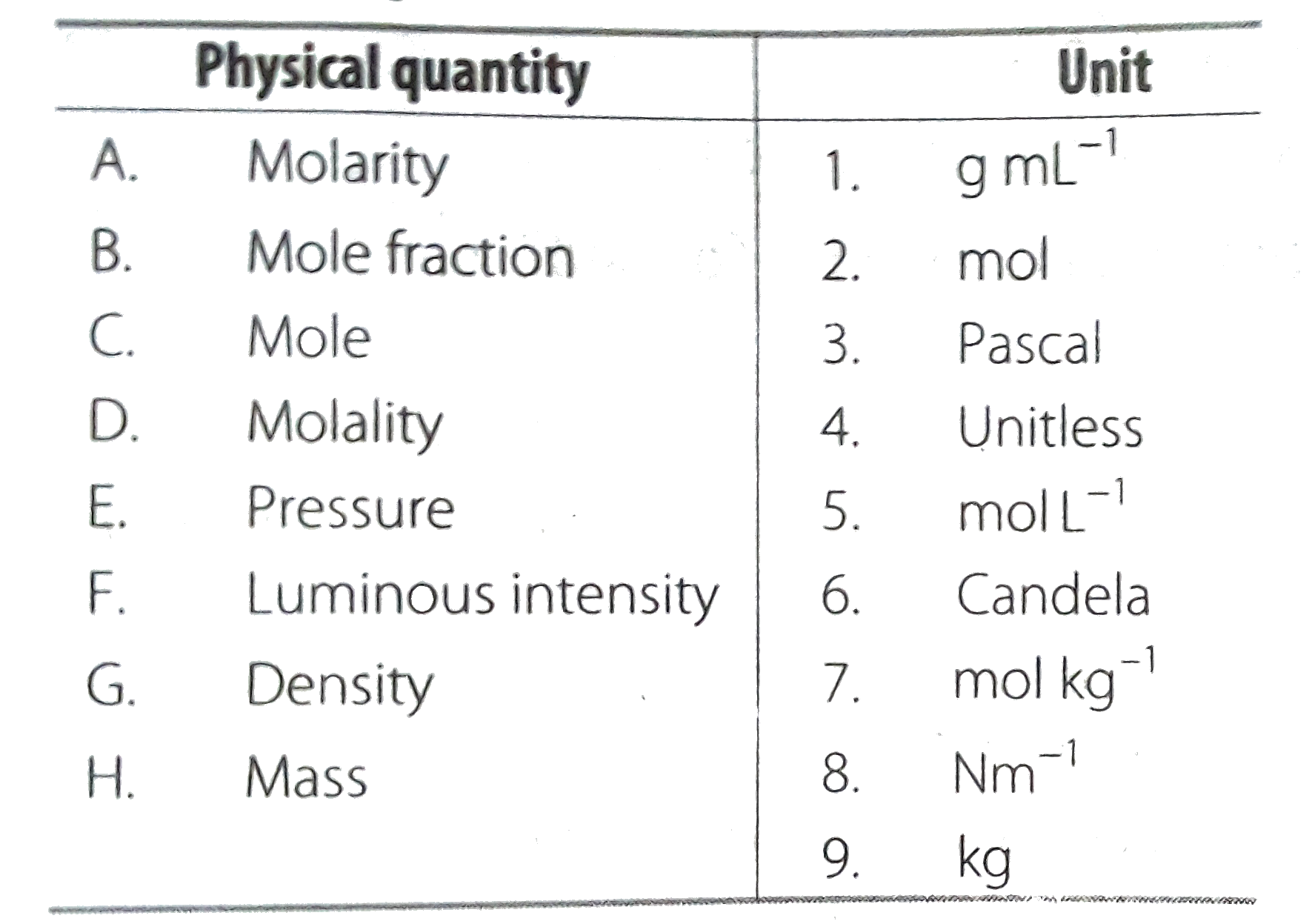Which of the following sets of physical quantities can be used as fundamental quantities in a system of units?
length, velocity and acceleration
length, mass and acceleration
length, mass and time
mass, time and accleration
The correct Answer is:B, C, D
To determine which sets of physical quantities can be used as fundamental quantities in a system of units, we need to analyze each option based on the dimensions they provide. Fundamental quantities are those that cannot be derived from other quantities. The fundamental quantities typically include length (L), mass (M), and time (T).
Let's analyze the options step by step:
Step 1: Analyze the first option - Length, Velocity, Acceleration
- Length (L): This is a fundamental quantity.
- Velocity (V): Defined as length per unit time (L/T). It is derived from length and time.
- Acceleration (A): Defined as the change in velocity per unit time (L/T²). It is also derived from length and time.
Conclusion: This set does not include mass (M) and therefore cannot be used as a fundamental set.
Step 2: Analyze the second option - Length, Mass, Acceleration
- Length (L): This is a fundamental quantity.
- Mass (M): This is a fundamental quantity.
- Acceleration (A): As noted earlier, it has the dimensions of L/T².
From acceleration, we can derive time (T) as follows:
- Rearranging the formula for acceleration gives us T = √(L/A). Thus, we can derive time from this set.
Conclusion: This set can be used as a fundamental set because it includes length, mass, and can derive time.
Step 3: Analyze the third option - Length, Mass, Time
- Length (L): This is a fundamental quantity.
- Mass (M): This is a fundamental quantity.
- Time (T): This is a fundamental quantity.
Conclusion: This set is a classic example of fundamental quantities and can be used as a fundamental set.
Step 4: Analyze the fourth option - Mass, Time, Acceleration
- Mass (M): This is a fundamental quantity.
- Time (T): This is a fundamental quantity.
- Acceleration (A): As previously noted, it has the dimensions of L/T².
From acceleration, we can derive length (L) as follows:
- Rearranging gives us L = A * T². Thus, we can derive length from this set.
Conclusion: This set can also be used as a fundamental set because it includes mass, time, and can derive length.
Final Conclusion:
The sets of physical quantities that can be used as fundamental quantities in a system of units are:
- Second option: Length, Mass, Acceleration
- Third option: Length, Mass, Time
- Fourth option: Mass, Time, Acceleration
- Length (L): This is a fundamental quantity.
- Velocity (V): Defined as length per unit time (L/T). It is derived from length and time.
- Acceleration (A): Defined as the change in velocity per unit time (L/T²). It is also derived from length and time.
- Length (L): This is a fundamental quantity.
- Mass (M): This is a fundamental quantity.
- Acceleration (A): As noted earlier, it has the dimensions of L/T².
- Rearranging the formula for acceleration gives us T = √(L/A). Thus, we can derive time from this set.
- Length (L): This is a fundamental quantity.
- Mass (M): This is a fundamental quantity.
- Time (T): This is a fundamental quantity.
- Mass (M): This is a fundamental quantity.
- Time (T): This is a fundamental quantity.
- Acceleration (A): As previously noted, it has the dimensions of L/T².
- Rearranging gives us L = A * T². Thus, we can derive length from this set.
The sets of physical quantities that can be used as fundamental quantities in a system of units are:
- Second option: Length, Mass, Acceleration
- Third option: Length, Mass, Time
- Fourth option: Mass, Time, Acceleration
Topper's Solved these Questions
- BOOK - MODERN PUBLICATIONCHAPTER - UNITS AND MEASUREMENTEXERCISE - COMPETITION FILE (OBJECTIVE TYPE QUESTIONS) (MCQs BASED ON A GIVEN PASSAGE/COMPREHENSION)5videos
UNITS AND MEASUREMENT
- BOOK - MODERN PUBLICATIONCHAPTER - UNITS AND MEASUREMENTEXERCISE - COMPETITION FILE (ASSERTION REASON TYPE QUESTIONS)6videos
UNITS AND MEASUREMENT
- BOOK - MODERN PUBLICATIONCHAPTER - UNITS AND MEASUREMENTEXERCISE - COMPETITION FILE (OBJECTIVE TYPE QUESTIONS) (MCQs) (JEE ADVANCED FOR IIT ENTRANCE)13videos
UNITS AND MEASUREMENT
- BOOK - MODERN PUBLICATIONCHAPTER - THERMAL PROPERTIES OF MATTEREXERCISE - CHAPTER PRACTICE TEST15videos
THERMAL PROPERTIES OF MATTER
- BOOK - MODERN PUBLICATIONCHAPTER - WAVESEXERCISE - CHAPTER PRACTICE TEST14videos
WAVES
Similar Questions
Knowledge Check
- Question 1 - Select One
Which of the following physical quantities has no unit?
ARelative densityBDensityCPressureDThrust - Question 2 - Select One
Which of the following sets cannot enter into the list of fundamental quatities in any system of units?
ALength, time and velocityBLength, mass and velocityCMass, time and velocityDLength, time and mass - Question 3 - Select One
Which of the following sets cannot enter into the list of fundametal quantities in any system of units?
Alength, mass and velocity,Blength, time and velocity,Cmass, time and velocityDlength, time and mass
Match the following physical quantities with units.
 View Solution
View SolutionOut of the following set of physical quantities , the vector quantities are
View SolutionWhich one of the following physical quantities is not a fundamental quantity ?
View SolutionUnited physical quantity
View SolutionWhich among the following physical quantities does not posses a unit?
View Solution

